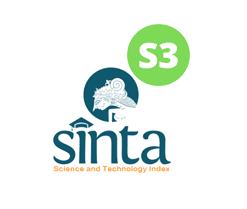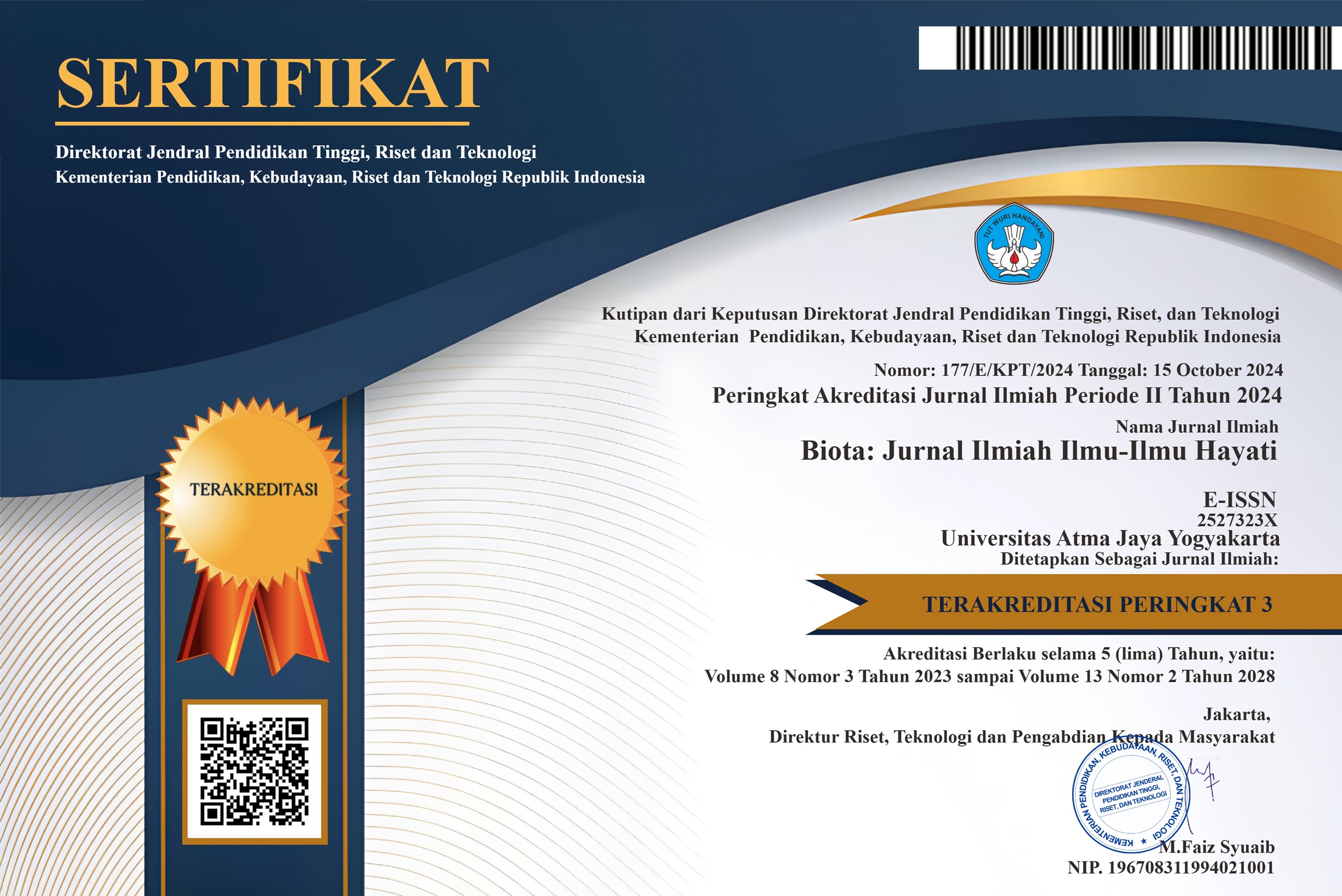Pertumbuhan Kerang Gafrarium pec Pertumbuhan Kerang Gafrarium pectinatum pada Ekosistem Mangrove di Pesisir Oransbari, Manokwari Selatan, Papua Barat
DOI:
https://doi.org/10.24002/biota.v8i3.7025Keywords:
alometrik negatif, ekosistem mangrove, Gafrarium pectinatum, parameter pertumbuhan, pola pertumbuhanAbstract
Kerang Gafrarium pectinatum, dengan nama lokal mambekorai, ditemukan pada ekosistem mangrove di pesisir Manokwari Selatan, Papua Barat. Sampai saat ini, spesies kerang ini masih dimanfaatkan oleh masyarakat setempat sebagai makanan. Penelitian mengenai populasi kerang G. pectinatum di lokasi ini bertujuan untuk mendeskripsikan pola pertumbuhan dan parameter pertumbuhan yang meliputi panjang asimtotik (Lµ), koefisien pertumbuhan (K), dan perkiraan umur (t0). Sampel kerang dikumpulkan pada tiga zona (bagian bawah, tengah, dan atas) dengan menggunakan metode transek dan kuadrat. Pada setiap sampel kerang dilakukan pengukuran panjang cangkang dan berat total. Sebanyak 194 individu kerang berhasil dikumpulkan. Ukuran panjang cangkang dan berat total secara berturut-turut berkisar di antara 19,6-44,1 mm dan 2,15-30,74 g. Nilai b yang diperoleh sebesar 0,7214 dengan pola pertumbuhan alometrik negatif yang menunjukan bahwa pertambahan panjang cangkang lebih cepat dibandingkan berat totalnya. L∞, K dan t0 secara berturut-turut sebesar 45,94 mm, 0,96 tahun-1, dan -0,15 tahun. Hasil penelitian diharapkan dapat menjadi acuan dalam memantau perubahan kondisi populasi kerang, sehingga upaya pengelolaannya dapat berlangsung dengan baik dan keberadaan sumber daya hayati ini dapat dipertahankan.
References
Admodisastro, V. A., Doinsing, J. W., Duisan, L., Al-Azad, S., Madin, J. & Ransangan, J. (2021). Population dynamics of asiatic hard clam, Meretrix meretrix (Linnaeus, 1758) in Marudu Bay, Malaysia: implication for fishery resource management. Journal of Fisheries and Environment 45(2): 92–105.
Akhrianti, I., Bengen, D. G. & Setyobudiandi, I. (2014). Distribusi spasial dan preferensi habitat bivalvia di pesisir perairan Kecamatan Simpang Pesak Kabupaten Belitung Timur. Jurnal Ilmu dan Teknologi Kelautan Tropis 6(1): 171–185.
Albert, D. D. A. & Bujeng, V. (2021). Strategi memungut spesies moluska paya bakau di Sabah dari perspektif etnoarkeologi. Jurnal Arkeologi Malaysia 34(1): 29–41.
Amir, A., Maturbongs, R. A. & Tapilatu, R. F. (2019). The impacts of coastal community activities on the existence of the Waranggui mangrove forest in South Manokwari, West Papua, Indonesia. Ocean Life 3(2): 54–64. DOI: 10.13057/oceanlife/o030202.
Argente, F. A. T. (2013). Commercially important mangrove bivalves of Visayas, Philippines. Dayew 1(1): 36–40.
Argente, F. A. T. & Ilano, A. (2021). Population dynamics and aquaculture potential of the mud clam, Geloina expansa (Mousson, 1849) (Bivalvia: Cyrenidae) in Loay-Loboc River, Bohol, Central Philippines. Journal of Sustainability Science and Management 16(4): 43–55.
Arranz, K., Labarta, U., Fernández-Reiriz, M. J. & Navarro, E. (2016). Allometric size-scaling of biometric growth parameters and metabolic and excretion rates. A comparative study of intertidal and subtidal populations of mussels (Mytilus galloprovincialis). Hydrobiologia 722: 261–275.
Aswani, S., Flores, C.F. & Broitman, B. R. (2015). Human harvesting impacts on managed areas: ecological effects of socially-compatible shellfish reserves. Reviews in Fish Biology and Fisheries 25: 217–230.
Atlanta, V., Ambarwati, R., Rahayu, D. A. & Mujiono, N. (2022). Diversity of bivalves on the north coast of Lamongan, East Java, Indonesia. Biodiversitas 23(8): 4263–4271.
Bahtiar, Purnama, M. F., Kasim, M. & Ishak, E. (2022). Population dynamics of blood clams Tegillarca granosa in Kendari Bay, Southeast Sulawesi, Indonesia. Biodiversitas 23(10): 5084–5092.
Beck F., Pezy, J. -P., Baffreau, A. & Dauvin, J.-C. (2015). Effects of clam rake harvesting on the intertidal Ruditapes habitat of the English Channel. ICES Journal of Marine Science 72(9): 2663–2673.
Bua, A. T. (2017). Struktur komunitas bivalvia di Pantai Juata Laut, Tarakan, Kalimantan Utara. Biota 2(1): 29–36.
Cappenberg, H. A. W. & Wulandari, D. A. (2019). Struktur komunitas moluska di padang lamun perairan Pulau Belitung Provinsi Bangka Belitung. Jurnal Ilmu dan Teknologi Kelautan Tropis 11(3): 735–750.
del Norte-Campos, A. G. C., Burgos-Nuňeza, L. & Lapara, S. (2023). Bivalve gleaning fishery in Batan Estuary, Aklan, Western Visayas, Philippines. Philippine Journal of Science 152(1): 219–229.
Doinsing, J. W., Admodisastro, V. A., Duisan, L. & Ransangan, J. (2021). Population dynamics and condition index of natural stock of blood cockle, Tegillarca granosa (Mollusca, Bivalvia, Arcidae) in the Marudu Bay, Malaysia. Acta Oceanologica Sinica 40(8): 89–97.
El Mekawy, H. A. M., Amer, M. A., El-Sayed, A. A. M. & Sarhan, M. H. (2021.) Biochemical composition of some bivalves collected from the western coasts of Suez Gulf, Red Sea, Egypt. Egyptian Journal of Aquatic Biology and Fisheries 25(3): 491–504.
Ferguson, G. J., Ward, T. M. & Gorman, D. (2015). Recovery of a Surf Clam Donax deltoides Population in Southern Australia: Successful Outcomes of Fishery-Independent Surveys. North American Journal of Fisheries Management 35: 1185–1195.
Fuentes-Santos, I., Labarta, U. & Álvarez-Salgado, A. (2019). Modelling mussel shell and flesh growth using a dynamic net production approach. Aquaculture 506: 84–93.
Gab-Alla, A. A. F. A., Mohamed, S. Z., Mahmoud, M. A. M. & Soliman, B. A. (2007). Ecological and biological studies on some economic bivalves in Suez Bay, Gulf of Suez, Red Sea, Egypt. Journal of Fisheries and Aquatic Science 2(3): 178–194.
Gayanilo, F. C. Jr., Sparre, P. & Pauly, P. (1996). FAO-ICLARM stock assessment tools User’s manual. FAO. Rome.
Gray, C. A. (2016). Evaluation of fishery-dependent sampling strategies for monitoring a small-scale beach clam fishery. Fisheries Research 177: 24–30.
Harris, M. & Weisler M. (2018). Prehistoric human impacts to marine mollusks and intertidal ecosystems in the Pacific Islands. The Journal of Island and Coastal Archaeology 13(2): 235–255.
Hulopi, M., Mose, S. W. & Uneputty, P. A. (2021). Analisa kepadatan dan identifikasi aktivitas pemanfaatan sumberdaya moluska di perairan Pantai Tanjung Tiram, Desa Poka. Jurnal Triton 17(2): 90–96.
Kilada, R. (2010). Validated age and growth estimates of two clam species in a saltwater lake on the Suez Canal in Egypt. Egyptian Journal of Aquatic Biology & Fisheries 14(2): 111–126.
Le Cren, C. D. (1951). The length-weight relationship and seasonal cycle in gonad weight and condition in perch, Perca fluviatilis. Journal of Animal Ecology 20: 201–209.
Lewis, D. E. & Cerrato, R. M. (1997). Growth uncoupling and the relationship between shell growth and metabolism in the softshell clam Mya arenaria. Marine Ecology Progress Series 158: 177–189.
Mendoza, D. M., Mendoza, G. M. & Rosario, G. R. (2020). Bivalve resources in the coastal Barangays of Infanta, Pangasinan, Philippines. Journal of Natural and Allied Sciences 4(1): 57–72.
Mendoza, D. M., Mula, M. G., Baysa, R. P., Fabian, R. A. M. & Mula, R. P. (2019). Spatial density, size, growth and condition index of mangrove clam (Polymesoda erosa) in the estuarine portion of Pasak River, Sasmuan, Pampanga, Philippines. International Journal of Fisheries and Aquatic Studies 7(4): 258–262.
Osei, I. K., Yankson, K. & Obodai, E. A. (2020). Demographic and profitability analyses of the West African mangrove oyster (Crassostrea tulipa) fishery in the Densu delta, Ghana. Journal of Fisheries and Coastal Management 2: 12–22.
Pauly, D. (1983). Some simple methods for tropical fish stock. FAO Fisheries Technical Paper No. 243. Food and Agriculture Organization. Rome.
Payton, S. L., Johnson, P. D. & Jenny, M. J. (2016). Comparative physiological, biochemical and molecular thermal stress response profiles for two unionid freshwater mussel species. Journal of Experimental Biology 219(22): 3562–3574.
Poutiers, J. M. (1998). Bivalves (Acephala, Lamellibranchia, Pelecypoda). In: K. E. Carpenter & V. H. Niem (Eds.). The Living Marine Resources of the Western Central Pacific. Volume 1 Seaweeds, corals, bivalves and gastropods. Food and Agriculture Organization of the United Nations. Rome.
Roa-Ureta, R. H., Henríquez, J. & Molinet. C. (2020). Achieving sustainable exploitation through co-management in three Chilean small-scale fisheries. Fisheries Research 230: 105674.
Roberts, E. A., Newcomb, L. A., McCartha, M. M., Harrington, K. J., LaFramboise, S. A., Carrington, E. &. Sebens, K. P. (2021). Resource allocation to a structural biomaterial: Induced production of byssal threads decreases growth of a marine mussel. Functional Ecology 35(6): 1222–1239.
Sa’adah, F. L. & Ambarwati, R. (2021). Struktur komunitas dan potensi gizi bivalvia di Pantai Selatan Kecamatan Sreseh, Madura. LenteraBio 10(1): 94–105.
Samori, F., Bawole, R. & Tebay, S. (2021). Struktur dan vegetasi mangrove di Warambui Distrik Oransbari Manokwari Selatan Provinsi Papua Barat. Jurnal Riset Perikanan dan Kelautan 3(2): 347–357.
Sienes, R. K. A., Lucaser, M. A. O. & Metillo, E. B. (2022). Population parameters of asiatic hard clam, Meretrix meretrix (Bivalvia: Veneridae), in Panguil Bay, Philippines. Mindanao Journal of Science and Technology 20(2): 228–242.
Soehendrawan, S. F., Lestari, F. & Kurniawan, D. (2022). Density and distribution pattern of bivalves in waters of Malang Rapat Village, Gunung Kijang District, Bintan Regency. Aquasains 10(2): 1049–1060.
Takar, S., Jawahar, P., Gurjar, U. R., Ramteke, K. K. & Kingston, S. D. 2023. Demographics and exploitation status of Gafrarium pectinatum (Linnaeus, 1758) (Bivalvia: Veneridae) along Thoothukudi Coast, Gulf of Mannar, India. Thalassas 39: 235-242.
Tanabe, K., Miyaji, T.,·Murakami-Sugihar, N.,·Shirai, K. & Moriya, K. (2020). Annual shell growth patterns of three venerid bivalve mollusk species in the subtropical northwestern Pacifc as revealed by sclerochronological and stable oxygen isotope analyses. Marine Biology 167: 20.
Waran, M., Aipassa, M. I., Manusawai, A. & Sinery, A. S. (2020). Diversity of molluscs (gastropod and bivalve) in mangrove ecosystem of Oransbari District, South Manokwari Regency, West Papua Province, Indonesia. Journal of Environmental Treatment Techniques 8(3):1220–1224.
Yahya, N., Idris, I., Rosli, N. S. & Bachok, Z. (2020). Mangrove-associated bivalves in Southeast Asia: A review. Regional Studies in Marine Science 38: 101382.
Downloads
Published
How to Cite
Issue
Section
License
Copyright (c) 2023 Frida Aprilia Loinenak, Elsa Ancolina Sembay, Gandi Yantri Sevantina Purba, Yuanike Kaber, Paskalina Theresia Lefaan, Duait Kolibongso, Emmanuel Manangkalangi

This work is licensed under a Creative Commons Attribution-NonCommercial 4.0 International License.
Authors who publish with Biota : Jurnal Ilmiah Ilmu-Ilmu Hayati agree to the following terms:
- Authors retain copyright and grant the Biota : Jurnal Ilmiah Ilmu-Ilmu Hayati right of first publication. Licensed under a Creative Commons Attribution-NonCommercial 4.0 International License that allows others to share the work with an acknowledgment of the work's authorship and initial publication in this journal.
- Authors are able to enter into separate, additional contractual arrangements for the non-exclusive distribution of the journal's published version of the work (e.g., post it to an institutional repository or publish it in a book), with an acknowledgment of its initial publication in Biota : Jurnal Ilmiah Ilmu-Ilmu Hayati, and as long as Author is not used for commercial purposes.













